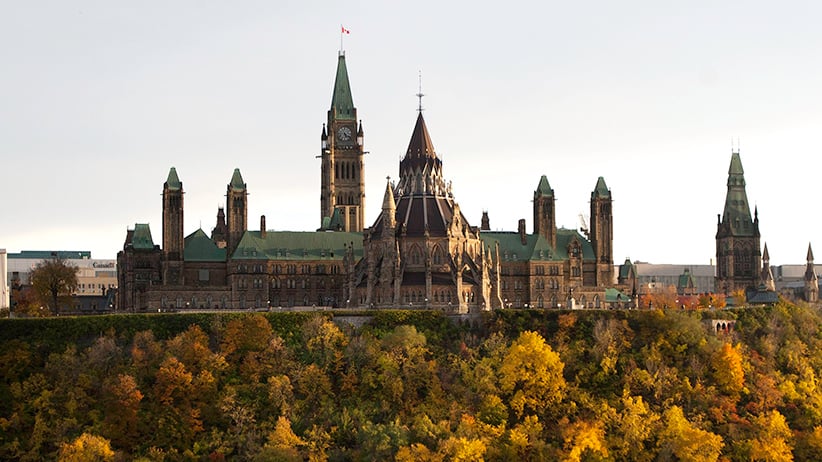Ottawa shooting: In the shadow of the Toronto 18
Ottawa has a long history as a stage for militants—and lessons of past breaches haven’t always been learned
Parliament Hill and the Library of Canada in the fall in Ottawa, Ont. on Oct, 18, 2012. Lars Hagberg/CP
Share

It’s seen as one of the sleepier world capitals—Canadian staidness wrapped in Gothic revival. But for political radicals and self-styled terrorists, Ottawa and its landmarks have long been enticing targets. From the assassination of Thomas D’Arcy McGee, a father of Confederation, to Wednesday’s shootings, assaults on the symbolic nerve centre of government, military and law enforcement have carried extra resonance.
Wednesday’s attack, for one, partially fulfilled a scenario plotted in 2005 by a group of radicalized young men in southern Ontario said to be inspired by al-Qaeda. The so-called Toronto 18 had planned a coordinated, suicidal assault on the Hill involving truck bombs, shootings in public areas and the storming of Parliament by armed men. They hoped, among other things, to behead Prime Minister Stephen Harper.
The scheme was distinguished as much by amateurism as bloody-mindedness. With the help of a mole, Mubin Shaikh, a joint task force of police and intelligence agencies was able to monitor the men as they trained with guns and explosives near Orillia, Ont., then catch them attempting to order ammonium nitrate fertilizer, an ingredient often used in crude bombs. In the end, seven men admitted guilt in relation to the plot, while another four—including one minor—were convicted in court. Charges against the other seven were dropped or stayed.
Related:
LIVE BLOG: Updates on the Ottawa shooting as details emerge
Parliament Hill shooting leaves soldier, 1 suspect dead
Ottawa shooting: Photos from the scene
Interactive timeline: What happened in Ottawa
Shaikh, then a Muslim activist, viewed the plot as fantastical. But the impact would have been enormous if the men had achieved even a fraction of their destructive mission. Court filings, he noted, revealed that senior members of the Toronto group had cased the Hill during their planning, marking out entrances where MPs came and went, and noting how many—if any—armed security officers were on hand, where they were located and what kind of guns they carried. “These things were openly discussed,” he says. “The plan was to have car bombs go off outside as a distraction so guys could enter the building.”
The case prompted parliamentary security to beef up screening protocols for people entering the building. But there were signs afterward that the area remained vulnerable. In December 2009, Greenpeace activists managed to scale the West Block of Parliament and unfurl banners decrying the government’s failure to address climate change. Though the group represented no physical threat, the ease with which it pulled off its stunt alarmed some observers, including Shaikh. “I had convinced myself that such a thing couldn’t be done,” says Shaikh, noting that the 2005 plot involved gunmen storming Parliament. “How wrong am I now? This is exactly what the Toronto 18 wanted to do. My jaw is still wide open here.”
It was by no means the first time that political and religious militants have used Ottawa as a stage. McGee became a target of Irish-Catholic radicals after denouncing the Fenian Brotherhood’s support for the U.S. takeover of Canada. On April 7, 1868, he was gunned down on Sparks Street, just south of the Hill, on his way home from a late-night parliamentary debate. He goes down as the only federal politician to be assassinated in Canadian history, but not the only victim of political violence in the nation’s capital. In April 1982, Turkish military attaché Atilla Altikat was shot and killed by a gunman while driving to work in Ottawa. An Armenian militant group claimed responsibility. Three years later, members of a different Armenian group stormed the Turkish embassy, setting off a bomb at the entrance and shooting security guard Claude Brunelle dead. The armed trio surrendered to police after a four-hour standoff, but not before the ambassador, Coskun Kirca, broke several bones jumping from a second-storey window in a bid to flee.
Finally, in April 1989, a Lebanese-Canadian named Charles Yacoub, armed with a .45-calibre handgun, hijacked a Greyhound bus and forced the driver to take it to Parliament Hill—apparently in protest of Syria’s involvement in Lebanon’s civil war. The bus bogged down on the lawn in front of Parliament, but Yacoub held nine passengers hostage for eight hours before surrendering to police.
Such incidents are a troubling reality of life in a world capital, of course. In Washington, a fence-jumper who recently got deep into the White House, and a gun-toting man who got into an elevator with Barack Obama in Atlanta, have drawn attention to security measures protecting the President, forcing the resignation of Secret Service director Julia Pierson. And while peace-loving Ottawa seems an unlikely site for radicalism, Canada’s part in military coalitions and counterterrorism initiatives is bound to put crosshairs on its capital. As Shaikh puts it: “Ideology and [Canadian] foreign policy are two powerful ingredients.”